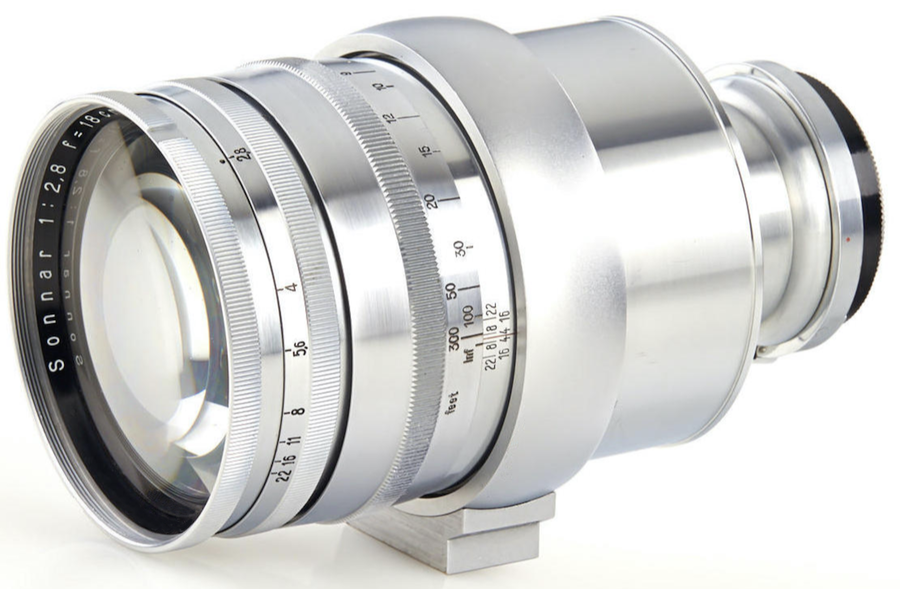
Olympia Sonnar
The very rare Zeiss Olympia Sonnar 18cm f2.8
with direct Zeiss ikon Contax rangefinder mount and coupling.
The lens shown here is an example of the first 300 production, of the 1936 Olympic Games period. (Nr.1998562). I recently acquired no. 1998523, the 123rd made and which is identical but not in quite as nice condition. It surfaced in Melbourne, Australia much to my surprise along with the multiformat Zeiss turret finder (18cm option, in near perfect condition, in Bakelite case). It has lost the bright metal, black lined, screw in 77mm metal hood/shade and the black leather Zeiss push on front lens cap. It also lacks the original leather covered wooden case supplied with all the original and also later 800 (?) pre-war Flektaskop mount lenses. It is still useable given the availability of lens adapters from Contax RF external mount to Sony ‘e’ mount and similar mirrorless digital SLR’s and I have shot with it on a Sony a7R III. I made a reasonable facsimile of the original hood from an aluminium hood for a Tamron 500mm mirror lens with a step-up ring, polished up (82mm rather than 77mm and approximately the same profile).
This example is from the third batch, made in November 1936 according to one reliable source. That 3rd batch consisted of 100 lenses from Nr.1998501-1998600. Before that only 100 lenses had been produced in two batches of fifty each – one just after the Winter Olympics in February although some prototypes were apparently used as a test of concept and another fifty in time for the Summer Olympics six months later. It is the extremely rare, original direct Contax rangefinder mount type developed and made with the 1936 Berlin Olympics in mind and for which the lens is famous – or notorious. It was found in a no-name leather case with other Contax mount lenses and the finder but no camera body.
This first 18cm f2.8 Zeiss Sonnar is historically important. It was, perhaps the first fast telephoto developed for professional sports photography and it is a heavy chunk of metal and glass weighing 1.3kg. It came in many versions from 1935 to through to at least the 1970’s, a very long-lived design indeed. Its longevity can be attributed perhaps to its convenient local length for sport and general press journalism, a wide aperture for the focal length, its ability to cover a 6x6 medium format negative and the pleasing nature of the images – sharp but with an excellent rendition of out of focus areas and highlights (bokeh). Because of this it later became popular as a portrait lens rather than a sports lens.
It was also made in mounts and styles for a range of cameras immediately after World War Two, both 35mm and 6x6. From the pre-war period, when it is thought that 1100 were produced in total, the more common 1938-40 version is usually found - in the large Flektaskop reflex housing. But many collectors are unaware that this very first type, used at the Olympics themselves, lacked the reflex mirror-box viewfinder mount. So it is referred to as ‘direct Contax mount’. However, the front of the lens is easily unscrewed from the large rear section with the tripod mount. It seems that there is enough space between the rear element and the actual lens mount to allow the mirror of the Flektaskop to fit in without much modification. The original lens may have been designed with the later reflex housing in mind, though that’s mere speculation on my part. Certainly it is likely that many of the originals were converted to reflex later in the 1930’s, once the option became available because it is quite difficult to handle and focus on the Contax rangefinder body without the reflex mount.
It has a fascinating history beyond its general design and use – it is significant both photographically and politically. It was commissioned or at least produced with encouragement from the Nazi government to record the 1936 Winter (February, Bavaria) and Summer (August, Berlin) Olympic Games. The Nazis had come to power democratically in 1932 and quickly set about promoting and legitimising their government and perverted political philosophy, including the claimed physical prowess and purity of the ‘German Aryan’ physical type which was at the poisonous core of their world view. It was realised that the photographic record of the sports event was vital for propaganda purposes.
But before the 1936 Olympics there were very few simple, lightweight telephoto cameras suitable for sports journalism as we now know it. Most were rather slow lenses in front of slow films in large and clumsy reflex cameras with large format negatives. Big wooden boxes unsuited to getting quick shots except by very experienced photographers in the street, rather than the stadium. Certainly there were no 35mm single lens reflex cameras with a ‘what you see is what you get’ prism viewfinder. That would come fifteen years later. This was also during the explosive growth of photography in the daily press, beginning in the 1920’s. Either the Leica or the Zeiss Contax rangefinder cameras could have been pressed into service as they had come to the fore in the early 1930’s as a quality lightweight camera but they were clumsy tools for this purpose except for close in work and neither of them had long enough fast lenses to allow the photographer to stand off the action in sport and freeze the action. They were best for press photojournalism where the photographer could get in among it, as in the coming war and later Vietnam war, where Leica distinguished itself. Zeiss had the background at the time in large, fast lenses and the Contax system with accurate focussing for faster lenses. They were the obvious choice then for something new. Leica did not catch up for years with the Visoflex reflex system and matching fast and macro lenses.
A famous 1936 movie, ‘Olympia’, was to be made about the games by young photographer Leni Riefenstahl, already a recognised director in her early thirties, to celebrate the Olympics and the prowess of Nazi culture. She was a visual artist rather than a journalist, who was nominally in charge of both the official movie and still Olympics photography. Riefenstahl had been appointed by the Ministry of Propaganda and Public Enlightenment (led by Josef Goebbels) to record the events as Goebbels recognised her talent and vision. She had made a domestically popular propaganda documentary, ‘Triumph of the Will’, showcasing the 1934 Nuremberg rally which was a personal project of Hitler (who appears in the credits as a writer and co-producer). It is still regarded as an innovative masterpiece of documentary and propaganda film making and made her reputation then and later, regardless of the subject (although many never forgave her and regarded her later work and life with disgust). With a crew of 42 movie photographers at her disposal to capture all the events and angles of the Summer Olympics in Berlin, she had an unprecedented level of coverage. Riefenstahl also had unprecedented access, to the point where she was allowed, for instance, to dig trenches next to the running tracks to allow shots of pounding feet, She was even permitted to force athletes, Germans at least, to restage their triumphs the next day or in the case of two American medallists, the next month in another country! The light was better?
The accumulated footage was the basis for the later movie but at the time was released to the then popular ‘Newsreel Cinemas’. In those days, there was no television so specialist cinemas showed news footage of that day and week, usually on a one hour rotation and often with light short films and cartoons between. There were clever fast editing and distribution techniques so that the day’s footage was in the cinemas within hours. Many of the newsreel cinemas were in central locations such as next to major railway stations so that people could go and watch the news on their way home from work or while waiting for a train. Once common, they mostly disappeared in the 1960’s as people acquired televisions.
Riefenstahl took a large number of still images herself, many of which are in collections and selected for their artistic merit, unlike most sports images. Unfortunately, the museums record the size and type of print (i.e. gelatin silver!) but not the camera and lens that was used. They tend to regard that as extraneous to the art like a painter’s brushes so we need to look for other clues in the images and some of them would suggest 180mm as an appropriate focal length as well as showing the typical soft background rendering of this lens.
So this Sonnar lens can be said to represent the birth of modern sports photography and it triggered a post war flood of fast tele lenses. Despite the Nazi‘s motives and culture, the quality of the journalism and their imagery was outstanding. Not only was the fast 18cm ideal for freezing athletic action with high shutter speed shots of events from a convenient distance but also it was useful for the very necessary political news shots of Hitler and other dignitaries in their viewing boxes while glad-handing the fans and competitors. New fast distribution techniques were pioneered such as having photographers on top of boxy delivery vans which gave them a good overview and which also had darkrooms inside so that prints could be prepared on the spot and motorcycle couriered to the newspapers. (No TV, no wireless!) I saw someone using a very similar technique a good seventy years later in the middle of a sports ground with a digital SLR and with a printer in the back of the Landcruiser, powered by a car battery. He was selling prints to parents on the spot at a children’s horse sports event. Simpler and easier but essentially the same approach.
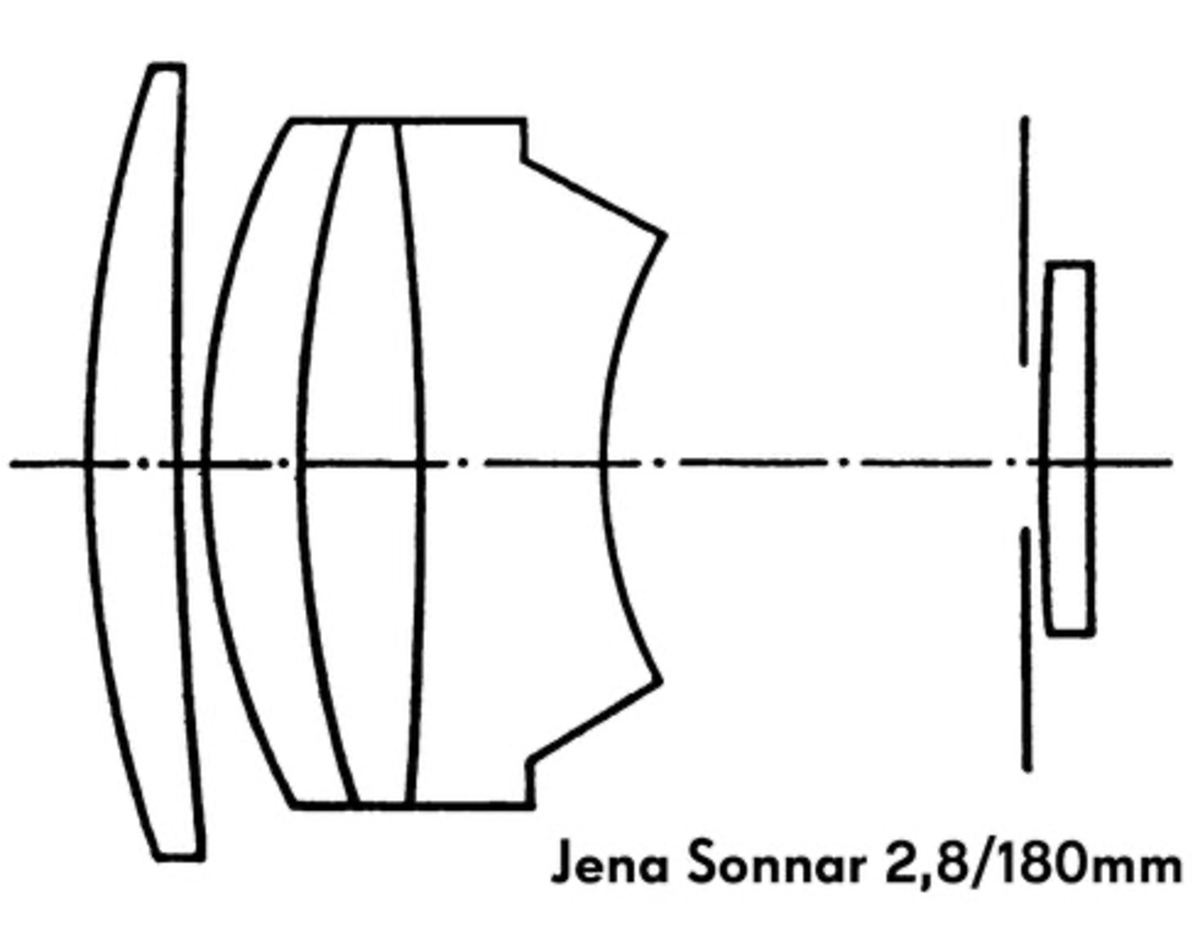
Zeiss used a Sonnar design of five elements in three groups, originally a development of the Ernostar lenses that Ludwig Berthele had developed in the 1920’s for Ernemann who were known for fast lenses. Berthele had then developed his Sonnar design for the Zeiss Ikon Contax in the early thirties, first the 5cm f2 and then the f1.5 version, after Zeiss Ikon absorbed Ernemann. Longer Sonnar focal lengths with fast apertures soon followed as the design worked very well for telephoto designs. These were superb and very fast lenses by the standards of the time; popular given that films were much slower than they are now. At the time the Olympics were being planned, the best that Zeiss had to offer as a sports lens was the Tessar 180mm f6.3. Tessars were a great design but slowish. Even the 50mm types do not perform as well below f3.5. That’s why Franke & Heideke used the Planar design for their Rolleiflex f2.8 models.
Berthele’s new Sonnar designs were revolutionary. Apparently he never became a regular employee of Zeiss in Jena after Zeiss had acquired Erneman but he agreed to work with them as an independent designer. He was self-taught unlike the university trained Zeiss designers, an autodidact, and it’s said that he feared that he would be treated as a subordinate if he went in-house at the venerable Zeiss organisation. He was too brilliant for them to quibble about his demand for independence so he was able to retain his status as a contractor and was able virtually to compete with the in-house designers.
To enable sharp photographs of moving athletes at the Olympic Games in 1936, a fast Sonnar type tele lens was produced by Berthele for Carl Zeiss Jena using a fluorite glass element to increase light transmission and to reduce chromatic aberration. The 18cm f2.8 Sonnar design was a little simpler than his earlier Contax 5cm designs, as usual with telephotos, with a 1,3,1 arrangement rather than the 1.3.3 of the 5cm f1.5 for instance. But it had the typical heavy Sonnar cemented three element set in front of the diaphragm.
Sonnar tele lenses are less fashionable today because a comparable image quality and lens speed can be achieved using cheaper lens constructions with new glass types, aspherical elements and without expensive fluorite glass. However, the bokeh quality of modern tele lenses is, as a rule, much harsher so you will still find modern Zeiss Sonnar telephotos made in Japan for high end cameras, at a price. (The 90mm for my Contax G for instance).
The original design was made with an 18 blade aperture. It started in a silver (aluminium) design and changed to a black body later. Later versions had 8 aperture blades and finally six, affecting the quality of ‘bokeh’. In all just 300 production 180's were made in the original 1936/7 period, in direct Contax mount with rangefinder coupling. As a viewfinder there was either a simple, dedicated, 18cm tubular scope finder or a turret finder with five focal lengths, including 18cm as the longest selection. That finder was more useful and convenient as it could be used with several other lenses in the kitbag without a change. Focussing was by the finder in the camera body which in the Contax has a very wide rangefinder base but it was still hard to focus accurately by rangefinder, users found. So did I! It is impossible to focus by the wheel on the camera and hard to hold the large lens and turn the focus ring without blocking the rangefinder patch's second window with your right hand or a finger, a perrenial problem I have with the Contax body. It’s a long and accurate rangefinder base but you have to learn how to hold it properly. Also the Olympia is so large that it not only blocks part of the viewfinder, it actually intrudes slightly into the right side of the rangefinder patch as well. So quick sports shooting as a modern sports photographer would expect to do with her big, white 400mm f2.8 autofocus is frankly impossible. But with care and perhaps on a tripod or the super-rare rifle stock mount, it is workable and far ahead of anything else at that time.
Given these difficulties in use and no doubt grumbles from the photogs of the time, the Flektaskop mirror box reflex housing was soon developed as an integral part of the lens mount. It converted the Contax to a crude SLR with a mirror lifted manually by a cable release, which then fired the shutter by a second coupled short cable. It’s believed that approximately 800 of these were made from 1938 to 1940 in that original Flektaskop version. This pre-war Flektaskop was awkward as it used a reflex mirror rather than a prism – a dim view, with the image reversed and inverted so it took practice to shoot athletes well - or anything else! The pre-war lenses were almost all uncoated though about 50 of the 1940 examples, made in black paint finish had the early ‘T’ coating. That totals 1100 made before and during the war though some sources claim fewer, perhaps as low as 800 total. All records were lost when Dresden and the Zeiss factory was bombed flat to rubble in the war and so the confusion is typical, relying on the unreliable claims and memories of survivors.
I have also seen images of a special military version (Luftwaffe) made in Leica screw mount, rangefinder coupled, in 1940-1. It was much slimmer and lighter than the regular type with an aluminium alloy body, possibly stripped down and lightened for use in aircraft. There were perhaps only four of them made, T coated.
Production was restarted of the 1940 single coated, 18 bladed type after the war in the late 1940’s with the Flektaskop finally being improved in 1949 by de-inverting the image and adding a spring release to the internal reflex mirror. Then the reflex unit was replaced in the final 1951 production sequence with the far superior Flektameter which had a brighter image corrected both vertically and horizontally. But by then it was all too late. It was by now a doomed concept, past its time as the modern style prism SLR, particularly the Exakta, was now available with big, fast 300mm and 400mm Kilar lenses for sport. (Think of the Hitchcock film ‘Rear Window’). Even so, the 180mm OIympia was being made in modified mounts for the new SLR’s. It proved popular as although it was heavy, it had a very pleasing ‘bokeh’, soft rendition of background out of focus areas.
The serial numbers of the original 300 or so Olympia’s are very confusing as the second sequential series of 100 numbers is out of order –
50x 1503701-1503750 (February 1936)
50x 1874901-1874950 (May 1936)
100x 1998501-1998600 (November 1936)
100x 1844901-1845000 (April 1937 ) - a later production batch but with earlier number).
Apart from the serial numbers, this sequence makes sense as it suggests that each of the first two batches were released for the two Olympic Games, in Winter and Summer 1936, probably for distribution to official Games photographers.
In fact the first batch missed the boat as production of the first batch of 50 started two days after the Winter Games though it appears that at least some prototypes were available. Photojournalist Lothar Rübelt was photographed using one at the Winter Games mounted on a rifle stock and with a crude lens hood and frame viewfinder. (The rifle stock became a very rare accessory).
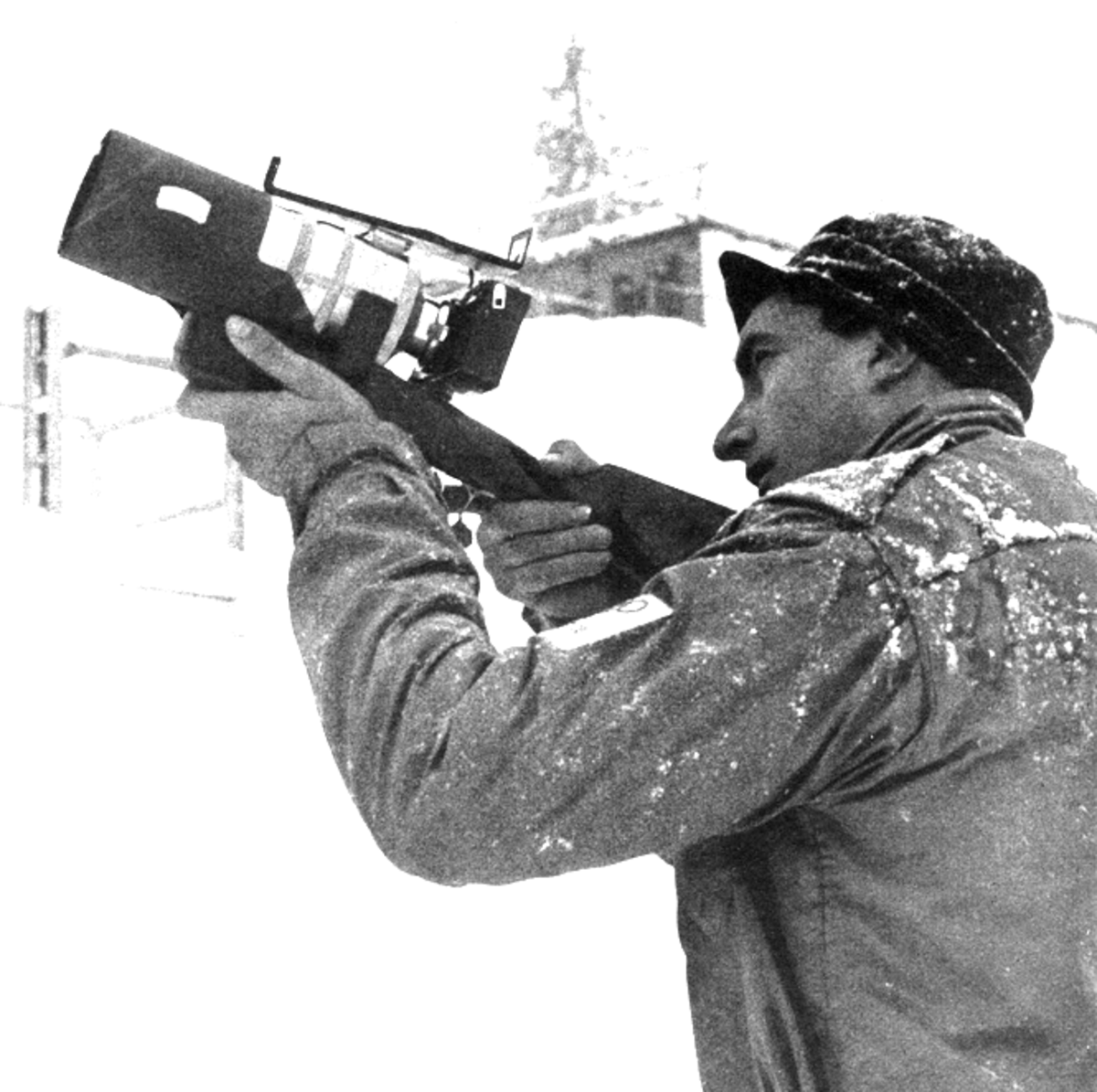
Lothar Rübelt in the snow at the 1936 Winter Olympics, apparently two weeks before the lens was available?! Note the rifle stock and improvised hood and long sight frame viewfinder. Later there was a now very rare Zeiss rifle stock to suit but it differs in design from this type and seems to have been designed later at Rübelt’s suggestion. This adds to the idea that he was using a prototype in jury rig, as proof of concept.
Then after the Games there was a larger production of two hundred in two batches, probably for more general use as they had been so successful in imaging the Olympics. What is also quite odd is that the two I've seen from the third batch of 100, Nov. 1936, have the focus ring engraved in feet only, not metres as you might expect. This suggests strongly that they were made for export to the UK and USA, possibly following interest from photographers who attended the Games and saw the lens in use by local German photographers. At first I thought mine may have been liberated by some keen soldier in the occupation forces in exchange for nylon stockings and chocolate or possibly less luxurious necessities but it seems more likely that it was a conventional export purchase in the 1930's.
Another source claims that the lens was actually designed in 1934 and the four production runs were completed in 1935 – also somewhat plausible as the German government was nothing if not well organised and the two Olympic games were an early propaganda showpiece. And at least one was known to have been in use during the Winter Olympics just before the first batch is said to have been released – we have the photographic evidence. (See above). So either Lothar Rübelt was using a prototype or the lens was already available, perhaps from the previous year. The best source I’ve found (zeissikonveb.de) says that the ”actual serial production" of the first batch of the lens started two days after the Winter Games finished but this is an odd way to express it. Is that when they started making them? Or when they released them officially? If the latter, then distribution to official photographers may have started some time earlier. On the other hand Rubelt is shown using the lens with a home-brew hood and rifle stock so he may have had access to a prototype for proof of concept.
The serial number blocks actually suggest a 1934 production date so the picture gets even more confused, although Zeiss may have assigned numbers to planned lens productions and then released them with the numbers out of chronological sequence. Not an unusual practice apparently. The serial numbers may have been assigned in 1934 when in the design phase but the lenses then not actually slid in under them until one or two years later. But this idea is undercut by the batches having distinct number blocks with reasonable chronological separation. If they had been preassigned, we’d expect the blocks to be closer or even fully sequential.
There is also considerable and continuing general confusion over the history and period of the different versions. I had thought myself that the earliest types had the reflex housing and when this one turned up, I assumed it was a later model. I It is common to see a Flektaskop model listed online as a 1936 Olympic example despite it being 1938 before the earliest reflex housing was added as I soon discovered. It seems, perhaps, that a Nazi Olympic history is seductive when selling one - as with other Nazi militaria. Note that the original 300 Olympic lenses all have a serial number just below 2 million. Also they are often referred to mistakenly as ‘Olympic’ rather than Olympia, the proper German name. I’ve even seen a description referring to the Olympia design as having a two element cemented group in front when the distinguishing feature of any Sonnar including this one is the three element cemented group design.
The number of survivors of the 300 in original form is unknown – many may have been later converted to a Flektaskop housing (easy done I think) and some will have been lost in the Second World War but it is certainly one of the rarest Zeiss production lenses in its original direct Contax mount form.
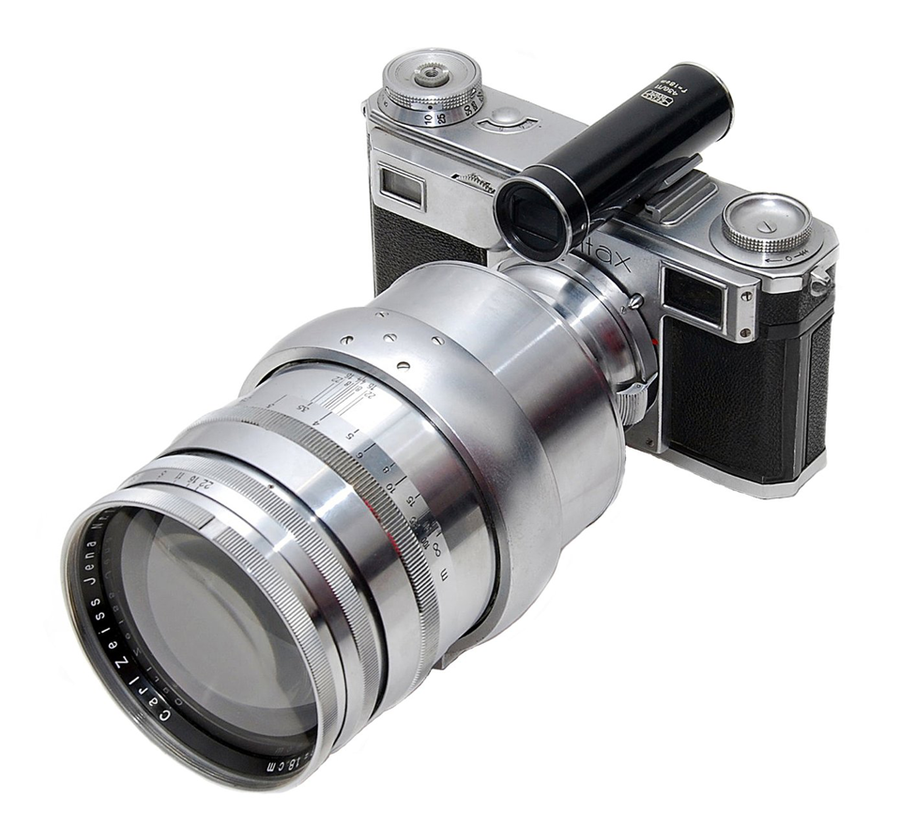
The original direct mount Olympia on a Contax with the dedicated 18cm viewfinder.
Specifications, 1936-7
original version
Uncoated (until 1938 Flektoscop version – then single coated)
Focal length: 18cm
Aperture: f.2.8 – f.22
Aperture blades: 18
Minimum focus distance: 1.5m
Filter size: 77mm
Weight: 1.365kg.
Length: 138mm
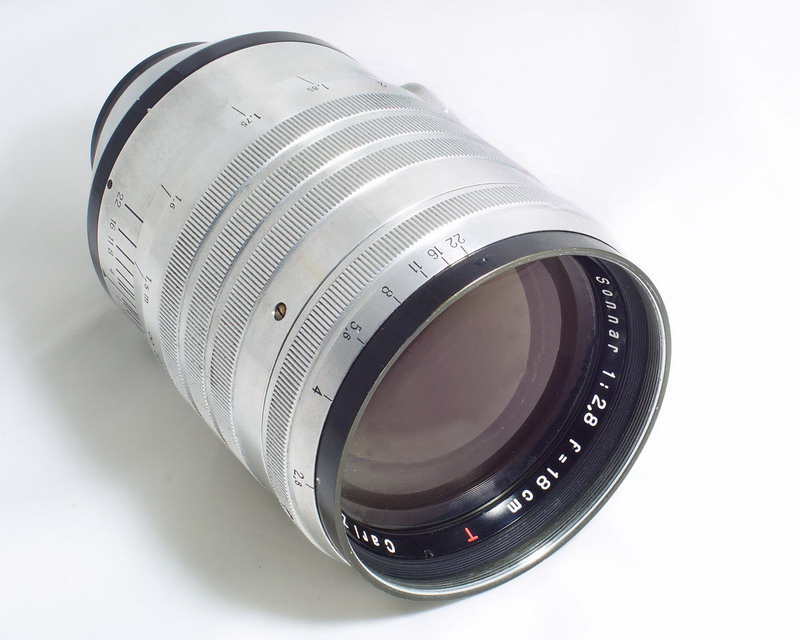
The ultra rare 'T' coated military version
of the Olympia created for
the Luftwaffe in the Second World War
Perhaps only 4 made.
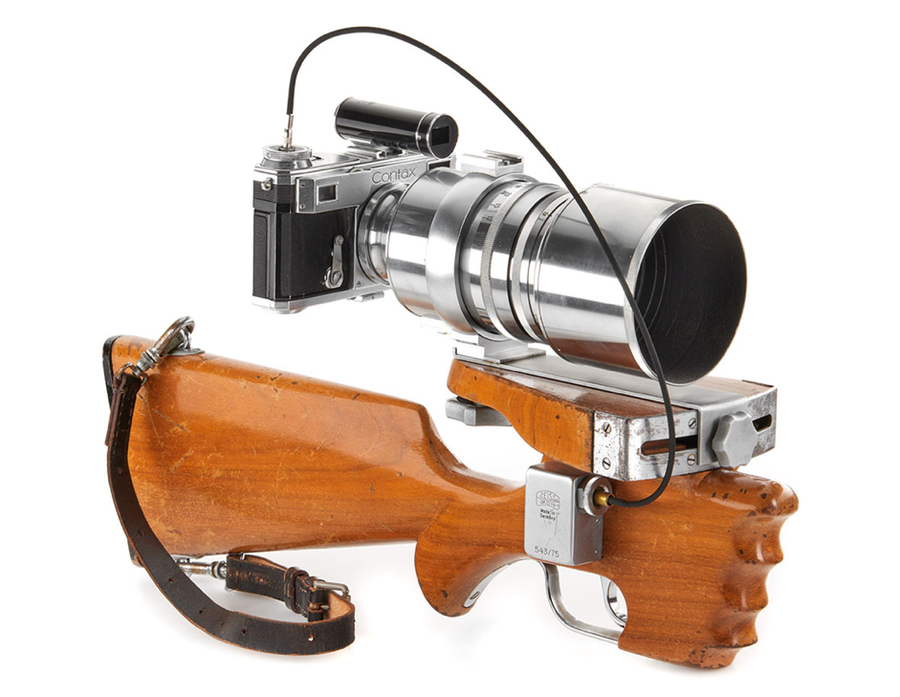
As good as it gets. The Contax camera with 18cm finder and an original Olympia mounted on the genuine and very rare Zeiss rifle-style stock.
This is lens Nr. 1874932 which makes it the 32nd of the second batch of fifty. (May 1936). Note that this earlier version has an accessory shoe on the top of the tripod mount - which Rubelt used for a frame viewfinder. The later two batches of 100 each lacked this feature so only the first 100 with this shoe mount were really used in the Olympic period..
The idea of the stock was credited to Lothar Rübelt but the design here is apparently more sophisticated than the one he is shown using at the February 1936 Winter Olympics.
Note also the truncated, shaped front hand grip and swing mount plate which looks clumsy but raises the camera to eye level and orients the camera to the user’s anatomical preference.
This outfit sold in 2021 for a mere 120,000 Euro. (Leitz Photographics Auction)
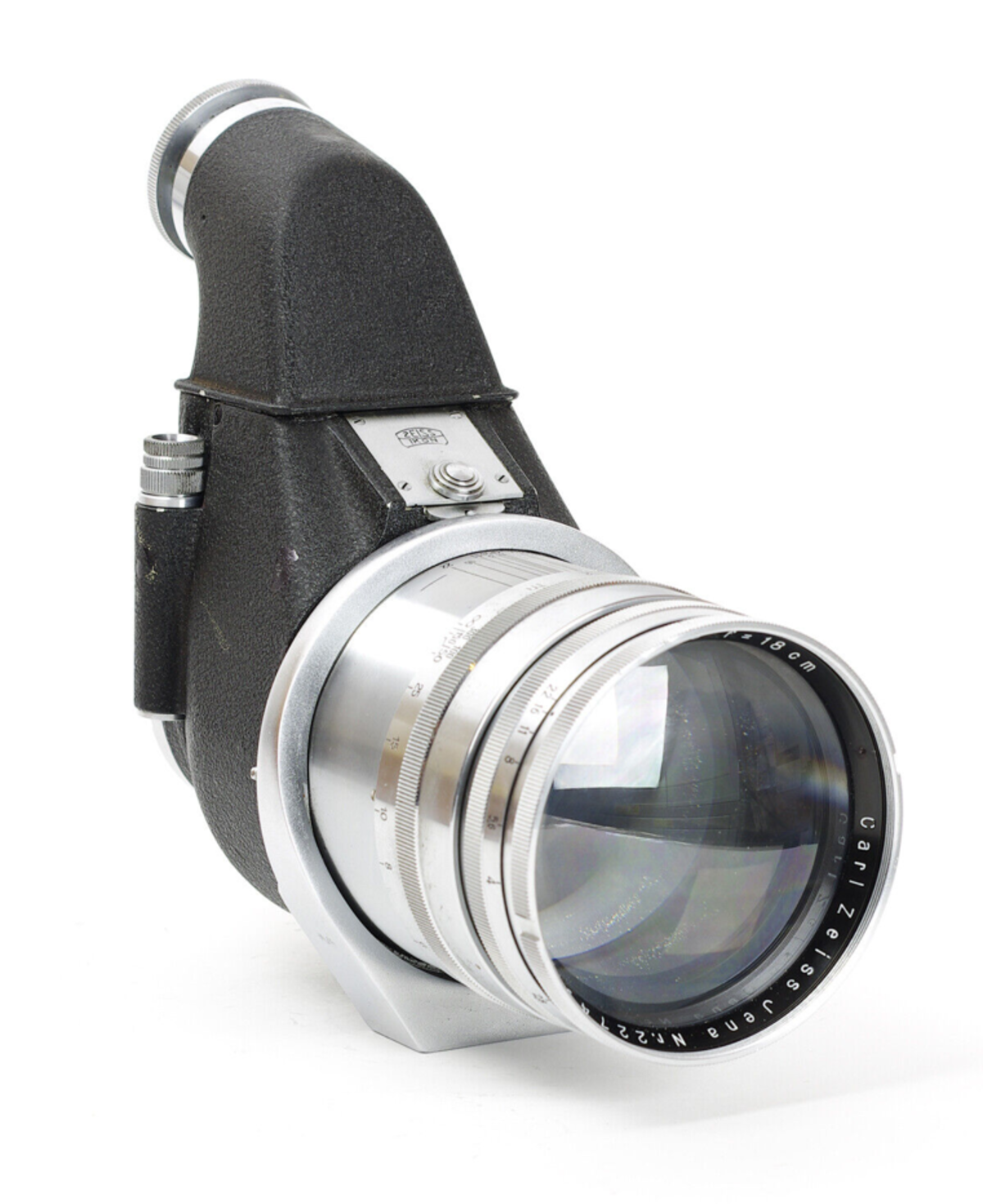
The later version Olympia single coated lens in the original 1938 Flektascop reflex housing. Some of the original direct mount production could have been converted to this later and much easier to use mount. There is little difficulty in unscrewing the original front element set housing from the rear, ‘direct’ Contax mount and plenty of room for the mirror behind the rear lens element so this reflex device may have been pre-considered in the original design stages. Whatever the facts, it means that original direct mount version could be even rarer than the 300 originally produced in 1936-7 especially considering that many would have been lost in the damage and confusion of the Second World War.
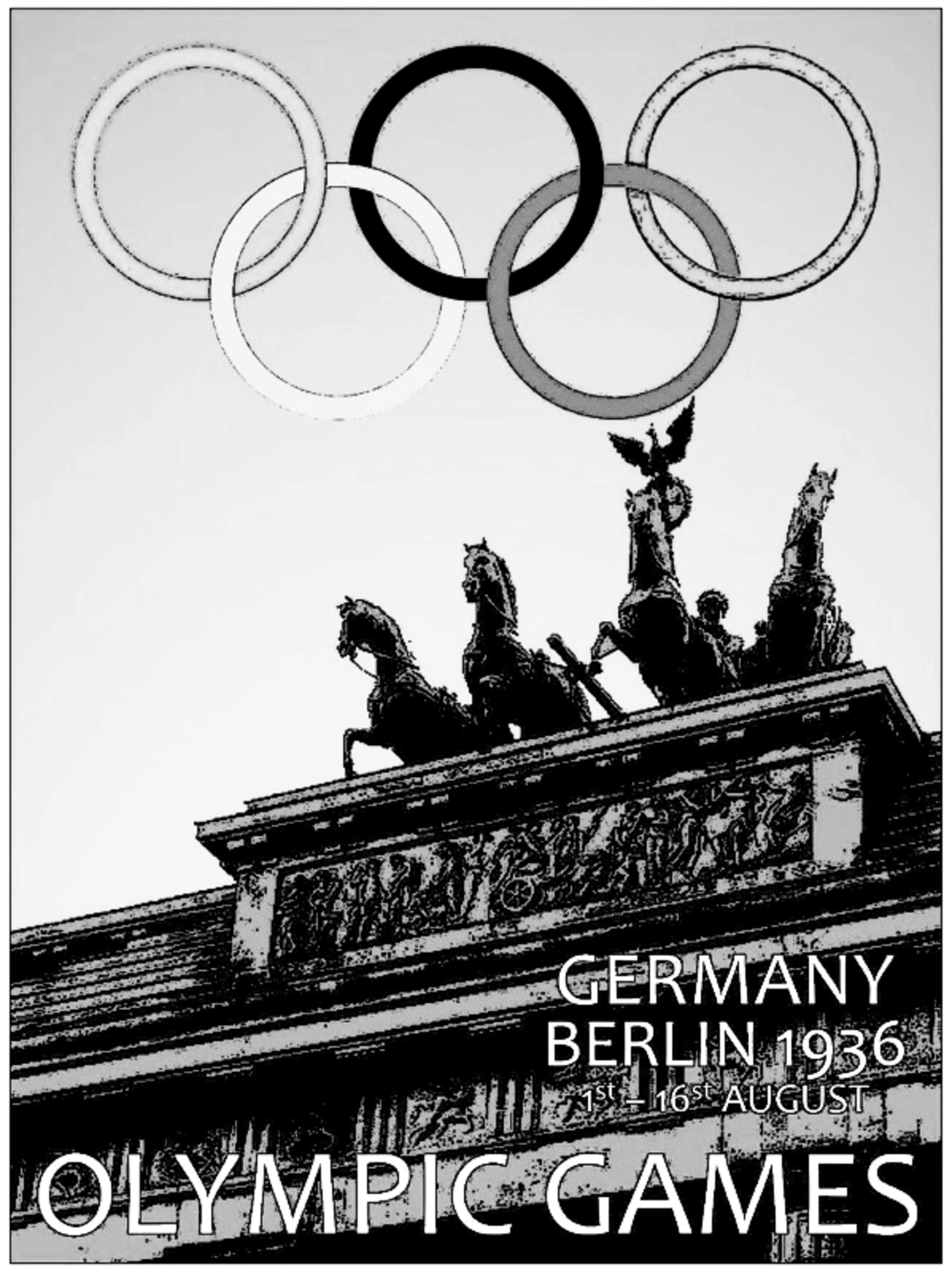
Using it Now?
And yes you can on digital as well as an original Contax or a Ukrainian Kiev. As I said, adapters are available for Sony 'e' mount and Fuji X mount and probably others. Most use them to mount a nice Sonnar 5cm f1.5 but...yes it does.This is No.123 on my Sony a7R III.
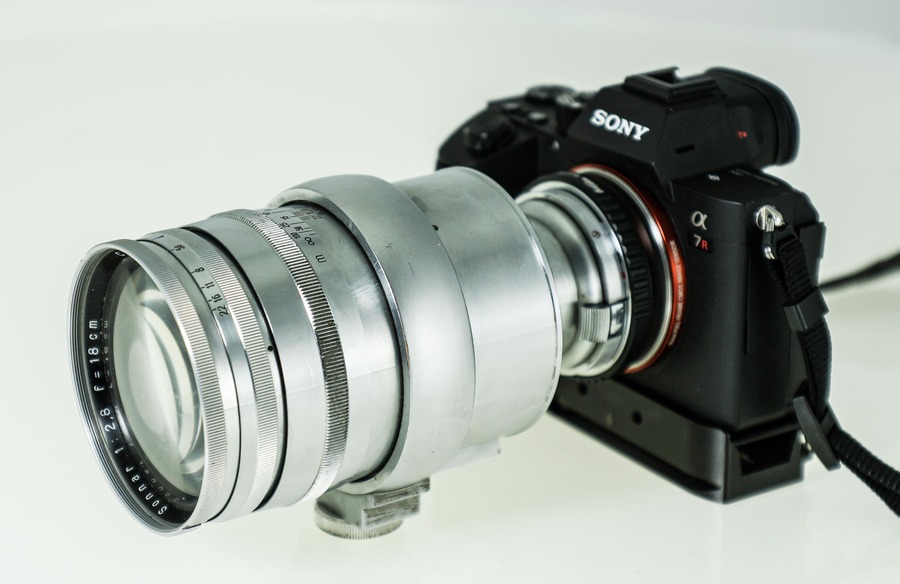
Girl with lightly salted potato chip - 18cm f2.8 Olympia on Sony a7R III.
